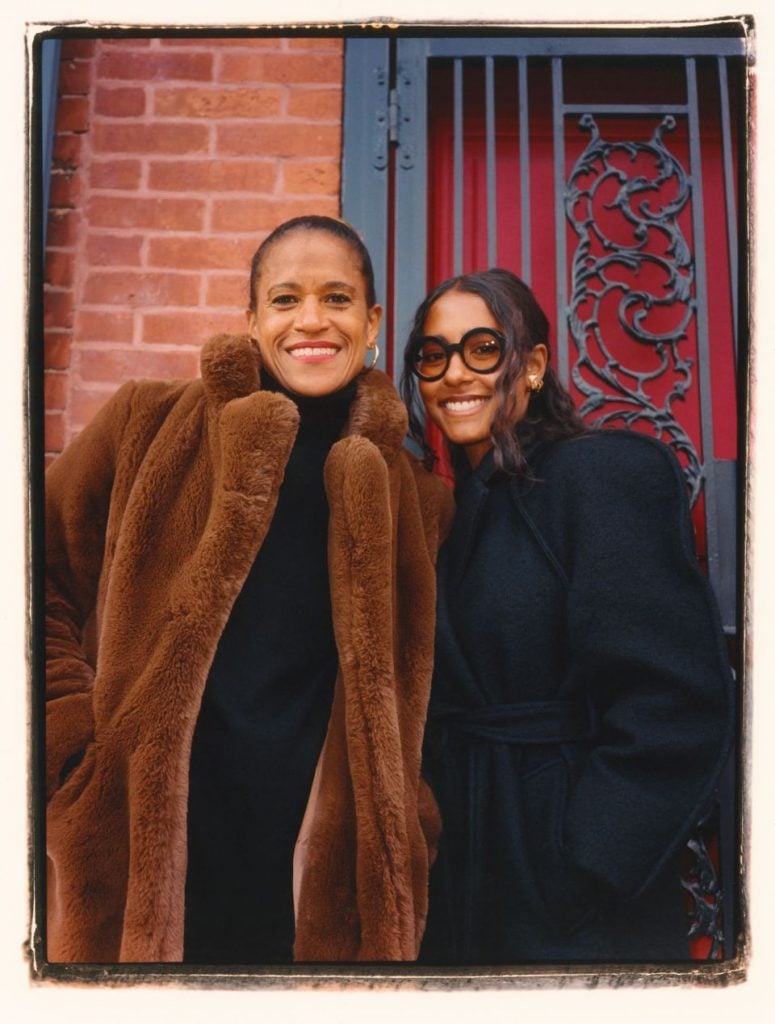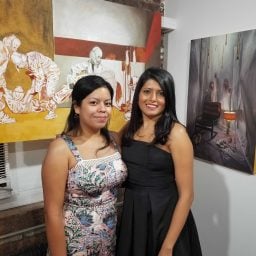Isolde Brielmaier, the newly appointed deputy director of the New Museum, is regarded by many young art-world stars as a deeply impactful guide and mentor. When she met Hannah Traore some five years ago, she formed an immediate connection with the now-budding art dealer.
As Traore set out to open her eponymous gallery, she drew on conversations she had had with Brielmaier about how to create a nurturing work environment, how to identify exciting artists, and how to carve a path as entrepreneurs and women of color in the art world today.
These conversations inform the ethos of Hannah Traore Gallery, which opens on New York’s Lower East Side on January 20. The debut show, “Hues,” features artworks by artists of color working with color, including Arielle Bobb-Willis, Dan Lam, and Patricia Renee Thomas. Also on view is “Mi Casa Su Casa,” an installation of work by Moroccan artists curated by artist Hassan Hajjaj.
Ahead of the opening, Artnet News sat down with Brielmaier and Traore to reflect on their bond and the importance of mentorship and partnership in the art industry.
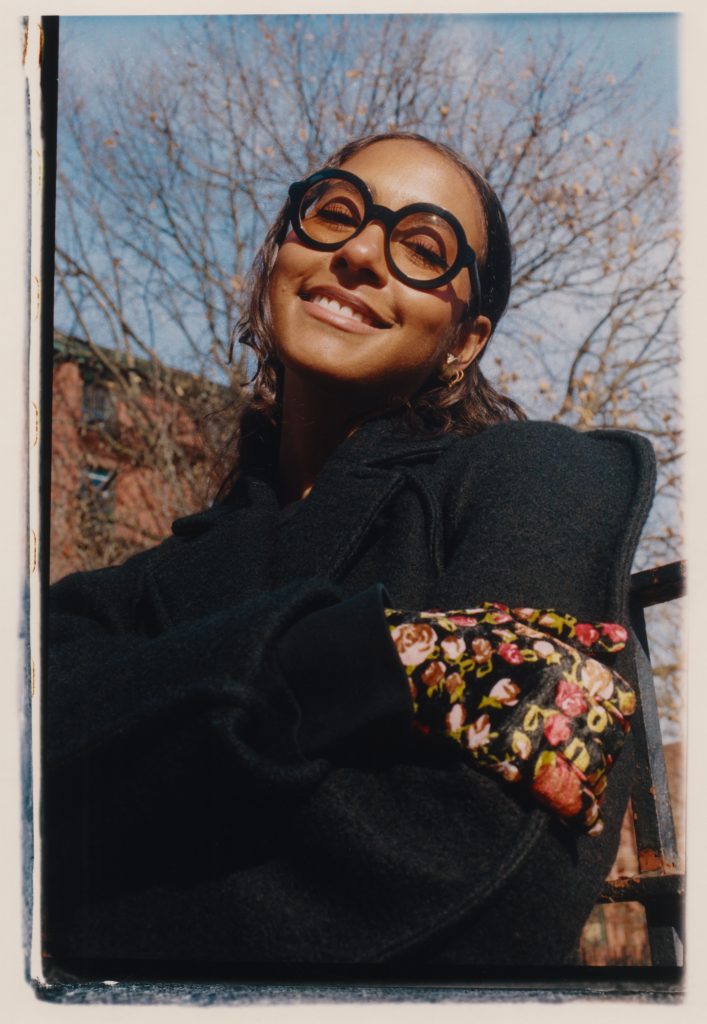
Hannah Traore. Photo: Sophia Wilson.
So Hannah, you’ve worked as Isolde’s project manager since 2020, and have contributed to recent exhibitions including “INWARD: Reflections on Interiority” at the International Center of Photography, where Isolde serves as curator at large. Can you tell me about how your relationship began?
Hannah Traore: We met in 2017 at the Tang Museum at Skidmore College, where I was curating an exhibition for my senior thesis and Isolde was the museum’s curator at large.
Isolde Brielmaier: When I met Hannah, we just immediately had a kind of synergy. I see a lot of myself in her. She’s a real go-getter and very ambitious, but very humble and kind and concerned about making sure that people feel comfortable and included.
Hannah Traore: We actually have this amazing selfie from then of me, her, and Hassan Hajjaj, which I found a couple of weeks ago. [Laughs] Right off the bat, I considered Isolde a mentor.
Isolde Brielmaier: The mentorship piece comes into play, though I don’t think of it specifically that way. I see it very much as a partnership. But even more importantly, I think of paying it forward. I always say that cliché, “standing on the shoulders of greatness.” So for me, that’s people like Carrie Mae Weems, Deborah Willis, my parents, and friends, both older and younger than me. I’m very aware that we don’t do what we do on our own in this world.
HT: Yes, Isolde wasn’t someone who just said, “I’m a mentor,” and then left me to my own devices. Then, during the pandemic, she needed a project manager, and that’s how we ended up here.
IB: And we have a great professional relationship, but we’ve known each other for several years and I consider Hannah a friend. If she has a personal issue, she feels comfortable coming to me and vice versa.
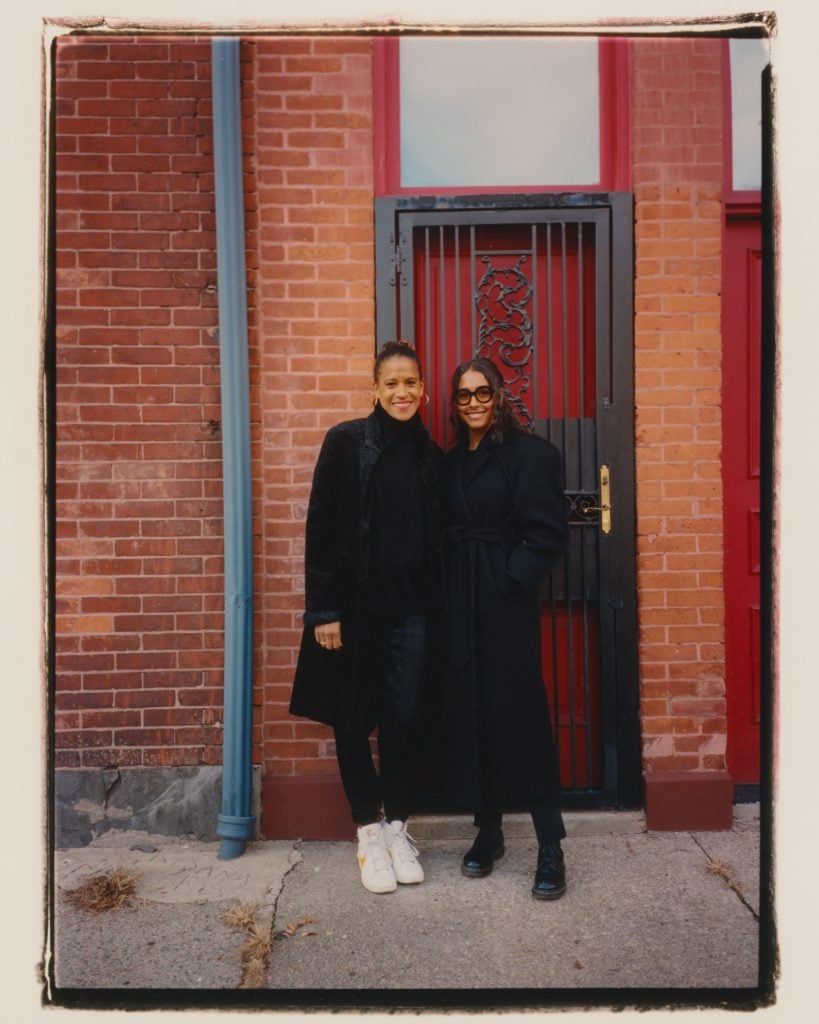
Isolde Brielmaier (left) and Hannah Traore. Photo: Sophia Wilson.
I’d love to hear about the workplace environment that Isolde created. Hannah, are there aspects of that culture that are informing the way you’re building Hannah Traore Gallery?
HT: I remember the first couple of weeks we started working, there were all these small things that really made me feel so appreciated. The relationship and the work environment was just so positive. Isolde always makes sure that I get the credit that I deserve. If there’s an event, she’ll always make sure people know that I worked on the project that we’re celebrating.
IB: Sometimes you help folks out or you offer them advice, and they just sort of take it and run with it and you never hear anything. But Hannah is so gracious and appreciative.
HT: People have always told me not to be friends with the people who work for you. That’s just not my personality. Isolde showed me how to make it work. Like she said, we’re professional, we come to work, and get everything done. At the same time, if I’m having a bad day, I can be the real me and tell her what’s going on. To be honest, I’m scared to be a boss because I’ve never been one before. I’ve had so many bosses that make me feel so small and self-conscious. Isolde makes me feel like she sees me as an equal.
IB: I think Hannah will make a great boss. She’s been honing her vision for the past couple of years, and it’s really exciting. I guess I am a boss, but I think of people that work with me as partners. Even in my new role at the New Museum, people talk about “staff,” but really they’re team members. It doesn’t take a staff to keep a boat afloat, but a team with the same vision and goal. Without that, the boat isn’t going to go very far. I think one of the most incredible qualities in humans, however spectacular they are, is humility. When we’re humble, it allows us to be open to learning and receptive to other people. I’ve also talked a lot with Hannah about how being humble doesn’t mean apologizing all the time or poo-pooing compliments.
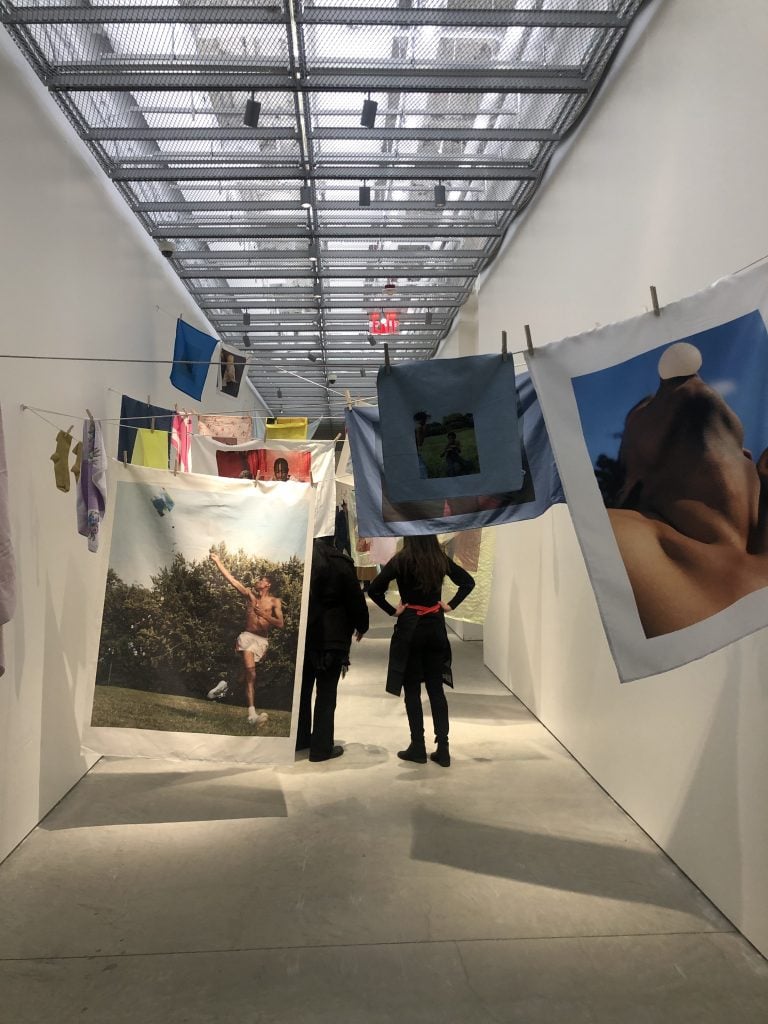
“Tyler Mitchell: I Can Make You Feel Good” at the International Center of Photography, New York. Photo by Jenée-Daria Strand.
In 2020, Isolde, you curated Tyler Mitchell’s first U.S. exhibition “I Can Make You Feel Good,” while Hannah, you’ve recruited an impressive lineup of artists for your inaugural show. How do each of you identify the different artists that you’re most passionate about and approach them to collaborate?
IB: Hannah and I overlap a lot in the artists who we really admire and follow. The other thing is that, for better or worse, we’re very curious people, sometimes maybe we should be a little less curious. [Laughs] We have our eyes and ears open, always looking at different work. Sometimes it’s not even work that we absolutely love, but are sort of intrigued by.
HT: It’s been really illuminating for me seeing the way that Isolde manages her relationships with artists. I’ve never worked with artists so closely before working for Isolde. That was a wonderful experience seeing how to work through problems when you and the artist don’t agree on something. Or how to tell an artist that one artwork might work better than the other with tact.
IB: As Hannah was building different ideas for her gallery program, she and I would go back and forth. And we do a lot of digging, looking through old and new catalogues. That’s one thing that I really enjoy doing with Hannah is building our different lists, for lack of a better term, of artists that we’d like to work with or include in something one day. It’s really a wonderful kind of dialogue.
HT: I’m also learning what a relationship between the artist and the curator can look like.
Again, it has to be a professional relationship, but in a way, you also want a friendship with them. And I’ve found myself doing that now with the work for the gallery. All the solo shows that I have set up, I feel like I have this really great relationship with the artists. I know that I got that from watching Isolde with the artists that we’ve worked with.
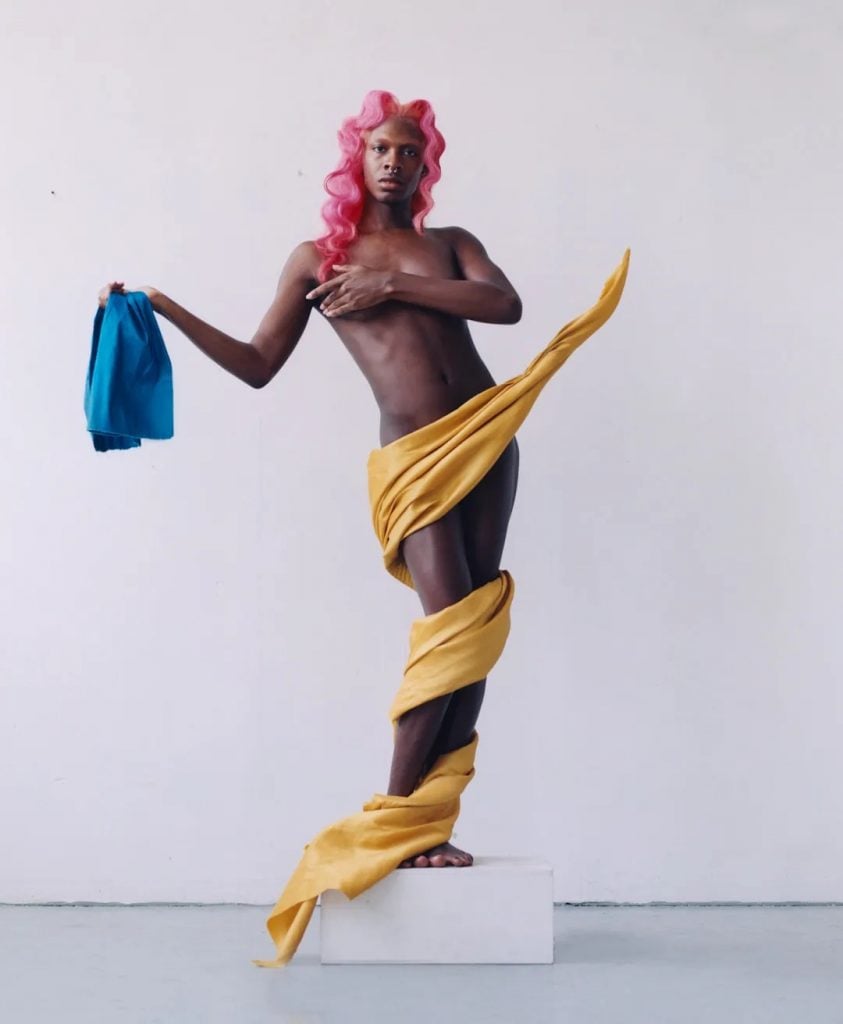
Camila Falquez, from the series “Being in History” (2021). Courtesy of the artist and Hannah Traore Gallery.
What is an important lesson you’ve learned about entrepreneurship, especially as women in the arts industry?
HT: I’ll say two things…one is that people will try to take advantage of you. I haven’t even opened the gallery yet and I’ve already experienced it. I don’t know whether that’s because I’m young, or a woman of color. Another thing I’ve learned is that people will try to tell you what your vision should be.
IB: I think it’s less, Hannah, about you being young. I think people love to have opinions. When it comes to art, everybody has an opinion. A lot of people, ourselves included, operate on their ego. We just happen to be able to keep them in check.
HT: Right. I’ve realized it’s about how you respond to it that’s important, right? You stick to your vision because it’s true to you.
IB: Exactly. As I’ve moved forward in my career, it happens less and less, but Hannah has seen me contend in public settings with certain things that people say, whether it’s a micro-aggression or just completely unprofessional. And in these moments, I call it out. I have no problem being unapologetically Black and unapologetically a woman.
HT: Yes! I’ll feel good about the way I respond, because I’m stepping into my power and I don’t back down, but it will bother me for days. I need to keep learning to let things roll off my back, which is what I see you doing, Isolde.
IB: It’s a constant process, I’m still thickening my skin. But at the end of the day, I am supported by so many people. I have an army behind me of women, in general, and Black women, in particular. And they will show up for me. Hannah and I are also such optimists and incredibly positive. We recognize things become difficult, and I think it’s very important to be able to talk about the realness of what’s going on. But we can either choose to be positive, which is a privilege I recognize, or get mired down in the negativity.
HT: Yes, and in other ways, there is a lot more support than I would’ve expected. I’ve been surprised at how communal a lot of women of color in this field have been, and how eager they are to help me with what I’m doing, since technically we’re supposed to be competition, you know? When I open the gallery, I don’t want people to see me as a competitor. I want people to see me as a collaborator. I see that with Isolde when I’ve been in rooms with her and her crew. It’s all kinds of women who in another world could be seen as competition, but that’s not at all the vibe.
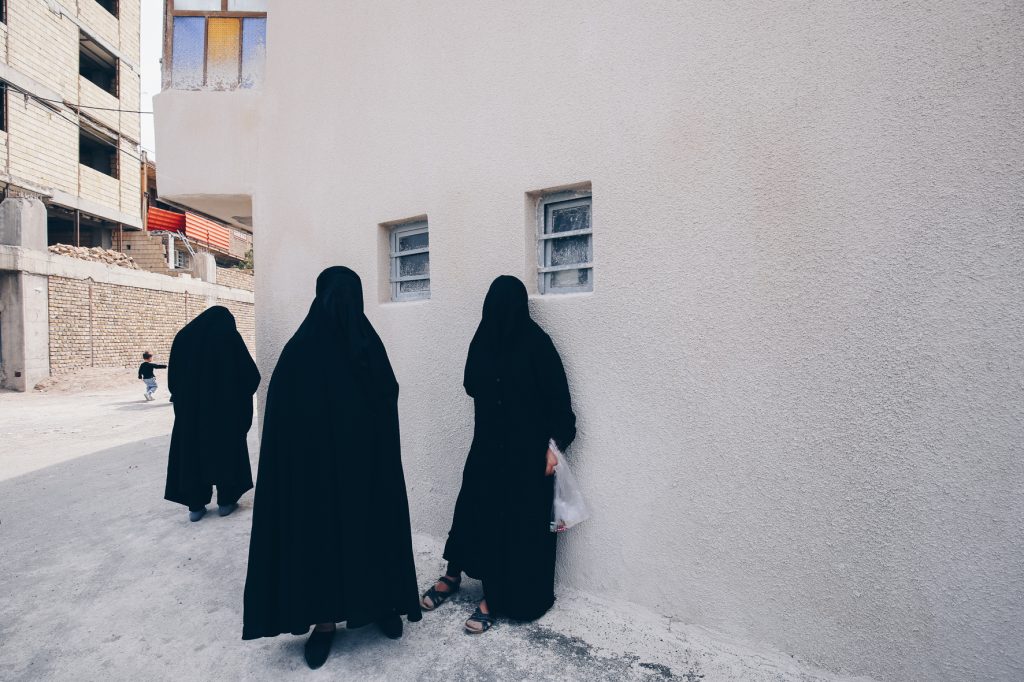
Youness Miloudy, Women on the street going to light candles front of houses, Morning of Muharram
Khorramabad, Iran 2018. Courtesy of the artist and Hannah Traore Gallery.
Are there examples of old or existing systems and structures throughout the arts industry that you hope to dismantle through your work?
IB: In so many ways they are the usual… inclusivity and diversity. But I also think that things like transparency around work, work environment, and pay are important. Developing a “culture of care” whether in the private or public sector is so important so that team members feel valued and cared for. I think that if we as BIPOC folks are more fully supported and set up for success, this is where we will see the huge impact be made.
HT: I think the most important thing is who is going to be shown in my space. You go to Chelsea and, though it’s getting better, the majority of artists are white and the majority of those artists are men. If we’re talking about the art-historical cannon, it’s even more [extreme].
Another important part is programming. How am I getting people into the space? I’m doing fashion collaborations and I would love to do some educational programs to bring different kinds of people into the gallery. I think that in real life, art is in conversation with all kinds of things, including education, media, fashion. Taking it out of that context and putting it on a wall feels like a disservice to the work to me.
